W6440ASX-1 Magnecraft / Schneider Electric, W6440ASX-1 Datasheet - Page 6

W6440ASX-1
Manufacturer Part Number
W6440ASX-1
Description
SSR, PANEL MOUNT, 480VAC, 280VAC, 40A
Manufacturer
Magnecraft / Schneider Electric
Datasheet
1.6210AXXSZS-AC90.pdf
(28 pages)
Specifications of W6440ASX-1
Control Voltage Range
90VAC To 280VAC
Operating Voltage Range
48VAC To 480VAC
Load Current
40A
Isolation Voltage
4000VAC
Control Voltage Type
AC
Relay Terminals
Screw
Lead Free Status / RoHS Status
Lead free / RoHS Compliant
2
INTRODUCTION:
SOLID STATE RELAY (SSR) is a relay with isolated
input and output, whose functions are achieved by
means of electronic components without the use
of moving parts as found in electromechanical relays.
PRINCIPLE OF OPERATION:
Solid State Relays are similar to electromechanical
relays, in that both use a control circuit and a
separate circuit for switching the load. When
voltage is applied to the input of the SSR, the relay
is energized by a light emitting diode. The light
from the diode is beamed into a light sensitive
semiconductor which, in the case of zero voltage
crossover relays, conditions the control circuit to
turn on the output solid state switch at the next zero
voltage crossover. In the case of nonzero voltage
crossover relays, the output solid state switch
is turned on at the precise voltage occurring at the
time. Removal of the input power disables the
control circuit and the solid state switch is turned
off when the load current passes through the zero
point of its cycle.
APPLICATIONS:
Solid State Relays are specially suitable in many
applications. Listed below are some typical
applications.
5
AUTOMATION
APPLIANCES
INDUSTRIAL
INDUSTRIAL
SOLID STATE RELAYS
APPLICA
MACHINGS
APPLICA
TOOLING
EQUIPMENT
SYSTEMS
MEDICAL
ALARM
TION DA
TION DA
ELECTRONIC
APPLIANCES
MACHINES
PACKING
T
T
A
A
APPLICATION AND SELECTION CRITERIA FOR
SOLID STATE RELAYS:
The Chart below indicates the areas in which SSR's
have better capabilities. (X) Indicates the Better choice.
LOAD CONSIDERATIONS
A major portion of application problems with SSR's result
from operating conditions which specific loads impose
upon an SSR. The following types of loads point out the
potential problems that can occur with SSR's.
DC LOADS: All loads should be considered inductive and
a diode should be placed across the load to absorb any
inductive surge on turnoff.
RESISTIVE LOADS: Loads of constant value resistance
are probably the simplest application of SSR's. Proper
attention to the steady state current ratings and applied
blocking voltage specifications normally will result in
trouble-free operation.
LAMP LOADS: Incandescent lamp loads, though basically
resistive, present some special problems. Because the
resistance of a cold tungsten filament is about five to ten
percent of the heated value, a large inrush current can
occur. The period of the inrush current can range from
one half cycle to several cycles, depending on the thermal
time constant of the filament. It is essential to verify that
this inrush current is within the surge specifications of
the SSR. Also check that the lamp rating of the SSR is not
exceeded. This is a UL rating based on the inrush of a
typical lamp. Because of the unusually low filament
resistance at the time of turn-on, a zero voltage turn-on
characteristic is particularly desirable with tungsten lamps.
It has been demonstrated that a zero voltage turn-on can
extend the life of tungsten lamps by limiting inrush current.
(Solid State Relays) or EMR's (Electromechanical Relays)
Temperature cycling
Arcless switching
Acoustic noise
Long life
Shock and vibration resistant
Immunity to false operation due to transients
Generation of RFI, EMI
Multipole
Multithrow (SPDT)
Size (includes Heat Sink) for equivalent load handling
Contact bounce
Zero voltage switching
Ease of diagnosing malfunction
IC compatibility
Immunity to humidity, salt spray & dirt
SOLID STATE RELAYS
SSR
X
X
X
X
X
X
X
X
X
EMR
X
X
X
X
X
X
















